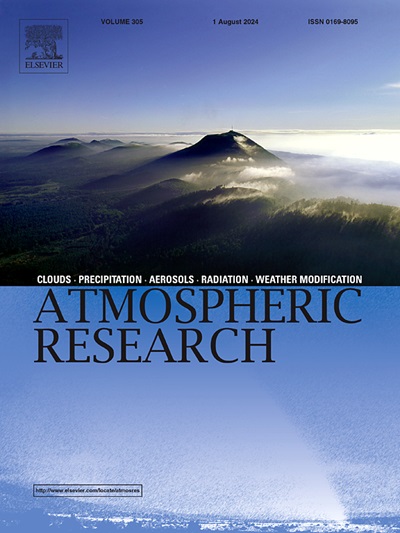华南雷暴中电荷结构的演变
IF 4.5
2区 地球科学
Q1 METEOROLOGY & ATMOSPHERIC SCIENCES
引用次数: 0
摘要
华南地区是中国雷暴最活跃的地区之一,但对该地区雷暴电荷结构的研究仍然有限。本研究利用广东闪电测绘阵列的闪电数据和雷达观测资料,研究了2021年6月16日发生在华南地区的一次雷暴的电荷结构。雷暴电荷结构经历了早期偶极子、成熟期三极子和耗散期偶极子的转变过程。初始偶极电荷结构中两个电荷区的高度迅速增加。在整个风暴中,三极电荷结构中正电荷较低的区域参与了总共1075次记录的闪光的11.8%。三个电荷区高密度电荷芯之间的平均距离从上到下分别为2.8 km和2.6 km。随着风暴进入消散阶段,上部正电荷区下降速度明显慢于大颗粒区,表现为该区域雷达反射率持续下降。上部正电荷区、中部负电荷区和下部正电荷区水成物主要为干聚集雪、霰和大尺度霰,分别占各区域总积的81%、67%和70%左右。在这三个阶段的过程中——低正电荷区域最初不参与放电,然后参与,然后停止参与——对流核心下降水的主要微物理过程分别是碰撞破碎、粒径分选和碰撞聚并。本文章由计算机程序翻译,如有差异,请以英文原文为准。
Evolution of charge structure in a thunderstorm over South China
South China is one of the most active regions for thunderstorms in China, yet, research on the charge structure of thunderstorms in this area remains limited. This study utilized lightning data from the Guangdong Lightning Mapping Array and radar observations to examine the charge structure of a thunderstorm that occurred in South China on June 16, 2021. The thunderstorm's charge structure underwent transitions from a dipole in the early stage, a tripole during its mature stage, and back to a dipole in the dissipation period. The heights of the two charge regions in the initial dipolar charge structure increased rapidly. Throughout the storm, the lower positive charge region in the tripolar charge structure was involved in 11.8% of the total 1075 recorded flashes. The average distances between the high-density charge cores of the three charge regions were 2.8 km and 2.6 km from top to bottom. As the storm entered its dissipation stage, the upper positive charge region descended significantly more slowly than the larger particles, as indicated by the continuous decrease in radar reflectivity in this region. The dominant hydrometeors in the upper positive, middle negative, and lower positive charge regions were dry aggregated snow, graupel, and larger-size graupel, respectively, occupying approximately 81%, 67%, and 70% of the total volume in each region. Over the course of the three stages—when the lower positive charge region was initially uninvolved in discharges, became involved, and then ceased participation—the primary microphysical processes in the precipitation beneath the convective core were collisional breakup, size sorting, and collision-coalescence, respectively.
求助全文
通过发布文献求助,成功后即可免费获取论文全文。
去求助
来源期刊

Atmospheric Research
地学-气象与大气科学
CiteScore
9.40
自引率
10.90%
发文量
460
审稿时长
47 days
期刊介绍:
The journal publishes scientific papers (research papers, review articles, letters and notes) dealing with the part of the atmosphere where meteorological events occur. Attention is given to all processes extending from the earth surface to the tropopause, but special emphasis continues to be devoted to the physics of clouds, mesoscale meteorology and air pollution, i.e. atmospheric aerosols; microphysical processes; cloud dynamics and thermodynamics; numerical simulation, climatology, climate change and weather modification.
 求助内容:
求助内容: 应助结果提醒方式:
应助结果提醒方式:


